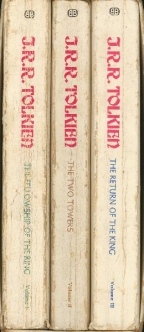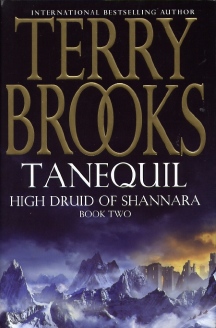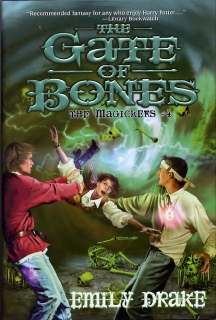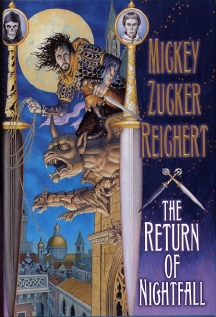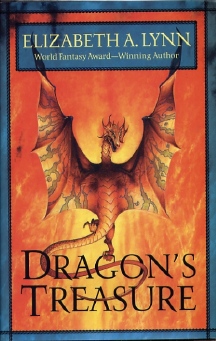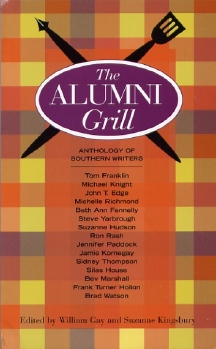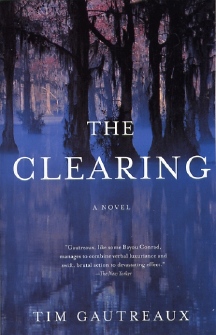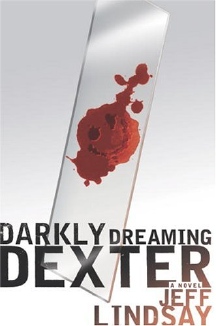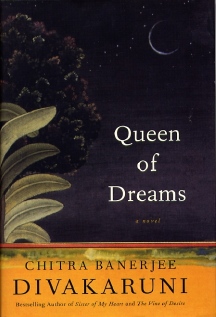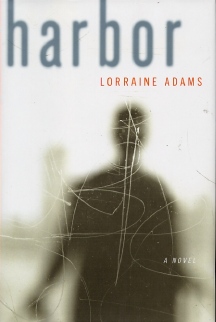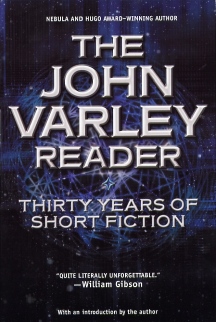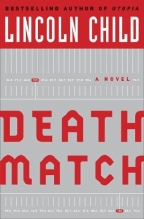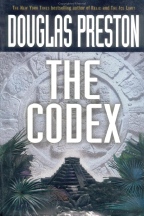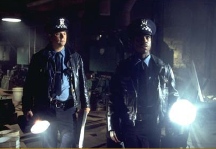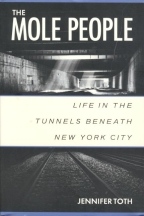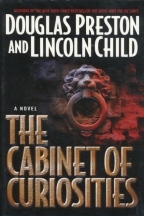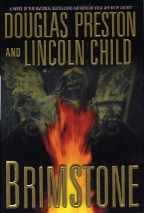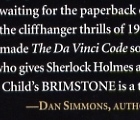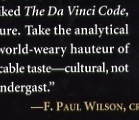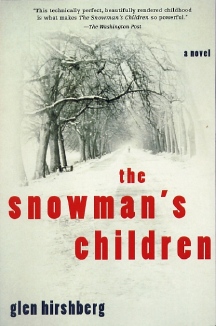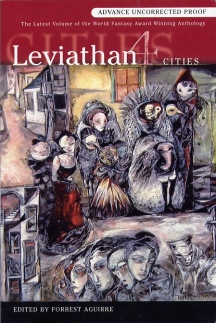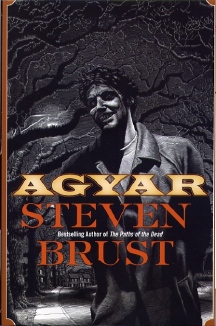|
|
|
This Just in..News from the Agony Column
|
08-27-04: Fantasy is Fantastically Profitable The Second Time Around; Southern Discomfort; A Writer's Dream Review in the New Yorker |
|||||||||||||||||
A
Slew of Sequels and a War of Words
Wait, that's one they haven’t answered -- to my reading knowledge. If I'm wrong, somebody write and tell me, I want to read that story. I want to live in that world, if only in writing. In this world, however, Tolkien wrote three books worth of 'Lord of the Rings'. And the result has been a torrent of trilogies - and more. Robert Jordan's 'Wheel of Time' series is at what -- ten, (or eleven, if you count the recent prequel) books. It's rolled from one century right into the next. Some may opine that's it's done rolled past the point where more is a good thing, though I rather enjoyed 'Crossroads of Twilight'. However, I took the shortcut to get to those Crossroads, reading summaries of the first nine books. My dogs were barkin' by the time I got there. This week sees the release of a batch of fantasy sequels, most of them book two in one series or another. I suspect that this is what is meant when they say that fantasy is outselling science fiction. And as usual, "they" have a kind of skewed idea of who the customer is. Let me explain it this way. When I worked at an unnamed company, said unnamed company made a product that we sold to stores, who then sold it to the final customers, the end users. For a long period of time, the Head of Sales opined that our customers were the stores we sold to -- particularly the chain stores -- and that drove our product design, our marketing strategy, and our company plan. It also drove us straight into the toilet. They had a barbecue celebration when said Head of Sales left for greener pastures. I suspect that similar drives affect/afflict the publishers, who might see the chain stores in particular as their customer. And sales are counted at the wholesale level (sales to bookstores) not the retail level (sales to readers). This is not to discount the work of the authors writing fantasy. They're doing fine work creating books that clearly appeal to millions of readers. And they're helping fund the appearance of authors who, though they gain critical raves from the likes of me, might not break the sales barrier. But part of that is down to promotion, and fantasy writers get a lot of promotion, especially when they're offering sequels to titles that sold well the first time around. And who can blame anyone in the chain? If you're a writer, and you create a world that sells the first time around, you're almost certainly going to have created a couple of novel-length stories in the process of creating that world. You can't help yourself. Readers are ever happy to see something familiar come down the pike; if it worked once, it will work again. That's why we can and should have auto-buy lists. And with the novels in today's news, quite a few readers' auto-buy lists are going to get a big fat checkmark.
While we're talking about fourth books, we'd be remiss not to mention 'The Gate of Bones' (DAW Hardcover, September 2004, $19.95), the fourth book in Emily Drake's 'Magickers' series. Born the turmoil of a post-Harry Potter world, the "Magickers' books hope to appeal to the same audience, and I don't see why they can't. In fact one hopes they do, at least to the teenagers who are actually reading Rowling's tomes. I mean, if the idea is to get kids to read -- and that's a great idea in my book, and if they like Harry Potter, then I say, send in the clones. The kids who are reading 'The Gate of Bones' today will be reading 'City of Saints and Madmen' two years down the line. And once they've set their minds afire with writing of that caliber, they won't want to leave their books behind. They'll learn to make time for books, which is precisely the skill that's needed. 'The Gate of Bones' finds the gang from the Iron Mountain Academy -- Jason, Trent, Bailey, Ting (Ting? Ting!), and Henry -- in Haven, having successfully opened the Dragon Gate. Alas, for every Gate, (as we should gather from Terry Brooks), there is an equal but opposite gate, in this case, the titular Gate of Bones. I'm guessing that nothing good comes through this gate. So we'll presume that book number five is on its way through the Dragon Gate, yes? So, as ever, there's a bit of a mystery about the author. Emily Drake is a pseudonym. Who is she? She offers a photo at her home page, but doesn't cough up the real deal. As long as that fifth book makes it through the Dragon Gate, we're good. But if it arrives through the 'Gate of Bones'...be afraid, no?
'The Legend of Nightfall' was Mickey Zucker Reichert's debut novel, and it went well enough for her that it established a career that's lasted eleven years. The first novel introduced Nightfall, who even to the Great Unwashed such as myself sounds pretty intriguing. Nightfall might be a demon, a magician or something completely different -- but in the end what he is is hard to catch. Thus, the sequel, 'The Return of Nightfall' (DAW Hardcover, September 2004, $24.95) begins with his capture. Once caught, he's bound by sorcery and wordcraft (that of the author) to guide a young prince on a quest. Forced to work with a one-time enemy, he's unsurprised when the prince disappears. Now he's making deals with the devils he knows, and at least has the good grace and sense to know that they’re not likely to go well. My guess is that even if Reichert sends him over Reichertbach, no Reichenbach Falls, he's likely to bob up somewhere along the line. Elizabeth Lynn has won two, count 'em two World Fantasy Awards. (The next set will be up for grabs in October.) Lynn won a WFA for her novel 'Watchtower' and her short story 'The Woman Who Loved the Moon'. It's been six years since Lynn wrote 'Dragon's Winter', a tart bit of unsentimental fantasy. 'Dragon's Treasure' (Ace Hardcover,September 7, 2004, $23.95) finds Kardur Atani fighting a foe he cannot hope to defeat -- his own humanity, especially as it brings him to fall in love. How many kingdoms have fallen on that sword? Alas, we no longer fight over such worthy trifles. These days, it's nukes, no nukes, who the nuke knows what we're fighting over? Better times are to be found in the pages of this or any of these novels. Here the evil is clear and present, the good may be flawed, but they sure as hell aren't blustering blow-hards. And thus the appeal of fantasy; clarity, even if it requires that the author invent an entire world to create just a smidgen of undiluted good. The paradox is that the good is not in the supposed good nor in the evil characters. The good is in the books themselves, in the purity of pleasure and presence of mind to be found in reading, something, anything. Start here. Maybe you'll end up in an alternate universe, one where fantasy has no need to come in threes. |
|||||||||||||||||
Macadam
and Cage Cook with The Alumni Grill, Tim Gautreaux steps into 'The
Clearing'
I immediately laid my hands on a copy of 'The Alumni Grill' (Macadam and Cage, August 4, 2004, $12.50), and I have to say that it seems like a bargain basement must-buy book. For a mere $12.50 you get a collection of southern-fried fiction that's alternately harsh, funny, and finally, real, real, real. It fires off with Tom Franklin's 'Christians'. Franklin is the author of 'Hell at the Breech', a powerful novel of crime fiction and vigilante justice. His story here begins as Bess Freemont buries her son. She knows that no justice will be done. Unless she does it. Other star authors include Steve Yarborough, Brad Watson and Beth Anne Fenelly. Her entries here are some of the best poetry that's gone through my eyes and into my brain in eons. She's so direct, so to the point, the poetry seems natural. Ron Rash chimes in with a wonderful short about what I used to do when I was but a lad on vacation with my parents -- 'White Trash Fishing', that is, night catfishing. Damn, we caught some huge-ass fish in the delta back then, and if we did that now, the things would glow and have to be disposed of with hazmat gloves. Oh well. I'm an old man, I can read about someone else doing it. That's what aging is all about. That and having some nice tart reading to make it all seem worthwhile. Of course, I did get my mini-William Gay fix after all in 'The Alumni Grill'. On the final page, under EDITORS, it tells me: "William Gay...lives in Hoenwald, Tennessee, where he is at work on his third novel." I'm a waitin'.
|
|||||||||||||||||
'Darkly Dreaming Dexter' by Jeff Lindsay
It was in fact my brother-in-law, a LA film editor, who told me many years ago that I'd like a novel called 'A Philosophical Investigation', the first novel by a guy named Philip Kerr. The premise was that in a near future of slightly advanced genetics, it was now possible to know who was genetically pre-disposed to become a serial killer. When a law-abiding pharmacist is tagged as a potential serial killer, he breaks into the database, snags the names of the other potential serial killers and starts knocking them off. Yes, it's the Patient Zero of the "serial killers of serial killers" sub-genre. That was ten years ago. Fast forward to today and you've got a bezillion-theaters movie based on the same theme starring, of all people, 'Ghandi', that is Ben Kingsley. (For the record, I enjoyed his performance in 'Sexy Beast'.) OK, so 'Ghandi' with a knife is in the theaters and on the bookshelves is 'Darkly Dreaming Dexter' -- the used bookshelves of Bookshop Santa Cruz. Dexter's a nice guy, really. Oh, he's a bit squeamish, even though he's a blood-spatter analyst for the local cops. But the real problem is that once he finds a serial killer, he makes them his quarry, hunts them down and kills them. Along with his social life, one presumes. Lindsay's Dexter is not a nasty customer. He's obsessively neat about his killings, and he immediately notices when he discovers he has competition. Oh, the humanity. Oh, the humor. 'Darkly Dreaming Dexter' looks pretty funny, and pretty fun to me. Read the first couple of pages and you'll get the vibe. It's sort of like 'Bright Lights, Big Knife'. Dress smartly, but understated. Don't make an ass of yourself. Blend in the background. And wear your surgical gloves. |
|
08-26-04: The Immigrant Express: Divakaruni, She's Our Baby; Who Are The Terrorists? |
|||
Queen
of Dreams
Rakhi is a young artist trying to keep afloat in an increasingly hostile world. Her mother is a dream teller, born with the ability to share and interpret the dreams of others, to use this to guide them through their fates. "A dream is a telegram from the hidden world," she tells her daughter. As much as this talent fascinates Rakhi, it also separates her from her mother, and from her mother's -- and her own past in India. Only when Rakhi finds her mother's dream-journals does she begin understand the burden and the power her mother carried. Rakhi will need all the understanding she can muster, as the world after 9/11 and the nightmares that follow lead her to new horrors -- and new possibilities. All this is fine and well, but I suggest that readers find the novel, pick it up and read, because Divakaruni's prose is beautiful and compelling. Here's a passage from the opening of the novel:
When readers buy the book -- and this is the
kind of book that oft becomes a regional (as in Northern California)
bestseller, hit up the
bookstore
for the Reading Companion Pamphlet. There's a decent introduction
and discussion points for your reading group. I'd suggest that reading
this and Mukherjee's
'The Tree Bride' back-to-back would be a pretty interesting reading
experience. There are a lot of similarities between the two that
would
likely create
that enjoyable synergy one gets when reading different independently
conceived novels that speak to similar themes. It's the kind of thing
that can get
into your dreams. |
|||
Lorraine
Adams Offers 'Harbor'
Aziz Arkhoun is a stowaway, an illegal immigrant from Algeria. Arriving in the hold of a tanker in Boston harbor, in the months before 9/11, he swims to shore and to a new life, no less violent and deadly than his old life. He's rescued by old friends from Algeria, and shortly afterwards finds himself immersed in a world of stolen identities, lies and a hand-to-mouth life not so very different from the life he led back home. But in that life, he buried the body of a murdered woman in the midst of the Sahara desert. Here, he finds himself stealing designer duds so that he can join the fashionable castaways clubbing and impersonating a double agent. A life of lies and deceptions, layers of truth and untruth sliding uneasily together in a series of tense encounters. Still, it's the immigrant experience in all its glorious complexity. Until he learns that he and his friends are under surveillance. Then he's finds himself wondering just who the terrorists are. The virtues of hindsight offer Adams ample opportunity for a variety of moods, from horror to hilarity. The potential for a powerful crossover novel -- part thriller, part literary examination of the immigrant's world -- is surely present. Adams has the insider's track in her pursuit of the truth that lies somewhere between the wiretaps and the interrogations, the secret societies and the lives of lies. Given the unaddressed complexity of what happens when a melting pot nation becomes terrorized by the very people who brought it into being, one can see why she would want to write fiction. But one would do well to worry just a bit, that the texture of the novel might convey the feel of the real more precisely than the reportage in the news. In the aftermath of 9/11, the news itself has become a safe harbor for fiction. |
|
08-25-04: The Madonna of the Maquiladora; The John Varley Reader |
|||
A
Conversation with Kem Nunn
Nunn was an engaging speaker, and passionate about his commitment to the environment, which plays a crucial role in 'Tijuana Straits'. In our interview, we spoke at length about the maquiladoras, the foreign owned factories that squat on the border between the US and Mexico. He told me about his experiences there, seeing residents carried out by men in hazmat suits. We also spoke a bit about the Juarez killings, a dark, disturbing labyrinth of murders that grow increasingly complex and insoluble. To my mind, 'Tijuana Straits' is a novel of very wide appeal. It offers a surreal, hallucinatory landscape for the readers who enjoy horror and science fiction, and it offers compelling characters who grab you from the first page. Nunn writes literary fiction that's compulsively readable, but has a nice resonance. As he told me, "We're all up against it, really..." Nunn's devotion to uncovering the universal truths in the particular lives he chooses to reveal is richly rewarding to his readers. While he's on tour, take the time to hear him speak. And if you can't, the interview will certainly give you insight into one of the great writers of his generation. |
|||
Isn't
That Just About Everyone?
And on this very day -- actually a few days hence -- The John Varley Reader (Ace Trade Paperback Original; September 7, 2004; $14.00) -- will bring to readers a summary of his 30 years as a writer of science fiction short stories, a life blood that still props up the genre in good times and bad. Varley's collection 'The Persistence of Vision' was one of those SF titles that grabbed my attention during my years as an English major, and kept my focus on the genre that academia was happy to ignore. Of course, first and foremost, you look at the titles offered in a new collection. 'The John Varley Reader' has all the stops that have made many of my days. First for me was 'The Barbie Murders', a science fiction mystery that introduced me to the "8 Worlds Stories". 'The John Varley Reader' offers all the other must-haves; 'The Persistence of Vision', 'Press Enter', 'The Pusher', 'Overdrawn at the Memory Bank' (filmed with Raul Julia for PBS) and 'Air Raid' (which was eventually filmed as 'Millennium'). Having checked off the list of essentials, it's essential to check what's not expected. In this case, you get five stories that have not been collected elsewhere. This includes 'Just another Perfect Day', which, the author tells us, bears a striking resemblance to a recent movie. 'Good Intentions' is Varley's first sale to Playboy, which as he notes is sort of the Holy Grail to short story writers. As he says, "they pay obscenely well." I suppose that should come as no surprise. Yet another reason to say you buy it for the articles! 'Just another Perfect Day' is linked with 'In Fading Suns and Dying Moons'. They both key off of another Holy Grail for writers of weird fiction, Oliver Sacks. Sacks' works of non-fiction are often weirder than most weird fiction, and they're certainly a great starting point for idea-miners. If you've been buying Sacks for this reason, then you're clearly in good company. 'The Flying Dutchman' offers a clever take on an old trope, and quite pertinent to those of us who have experienced air travel since 9/11. Then there's the nugget of gold. A story from the Holy Grail. 'The Bellman' was to be John Varley's entry in Harlan Ellison's famously unpublished anthology 'The Last Dangerous Visions', itself something of a Flying Dutchman in the science fiction world. At long last, this story at least, is available here. Varley now has a website, and if you;'re interested in his work -- and you should be -- you can visit it here. He doesn't exactly have a blog, but what he calls Varley yarns, which are just that -- stories of what John Varley gets up to, which, as you can imagine is some fairly interesting stuff. From political opinions to a satellite launch diary, you'll find some interesting reading. There's a nice bio, a bibliography and pictures. He even lets readers in on recent news, such as the his recently completed novel, 'a time travel novel featuring "Little Fuzzy, Child of the Ice Age."' But the real reason to buy just about any collection is not simply the fiction. In 'The John Varley Reader' Varley himself has written extensive and utterly entertaining introductions, some that, as he says, "..threaten to become longer than the story itself." That's not just OK, that's grand. Varley's war stories of life at the top of the SF genre are fascinating glimpses into the professional writing life. They're long enough to be rewarding -- and re-read -- just for their own content. Varley mentions at the end of the collection that he managed to get the intros to his editor a month late. For this reader, the high quality of what he writes here makes it well worth the wait. Would-be writers of science fiction had best pay attention. Varley talks quite a bit about his beginnings here. This is informative and essential information for anyone who hopes to pursue a career in writing. As it happens 'The John Varley Reader' is more than a simple collection. It's the description of an entire generation of readers, those of us who grew up in the turbulent 1970's. |
|
08-24-04: Agent Pendergast Is On the Prowl Again |
|||||||||||||||||||||
Douglas
Preston and Lincoln Child Bring You Brimstone
Furthermore, they both have the power to mildly annoy me. What the heck are these guys doing, I think, writing these watered-down thrillers when they're clearly capable of superior, burger-busting slabs of cheese?
Because they followed that up with 'Reliquary' -- essentially monsterS in the museum. Well, it worked for James Cameron, going from Ridley Scott's 'Alien' to his own 'AlienS'. And it sort of works for Preston and Child, though their "mole people" riff was overshadowed by both the sobering and frightening documentary 'Dark Days' and Jennifer Toth's own non-fiction book about The Mole People'.
Alas, then P&C ditched the man for a series of novels that lacked appeal to this reader because 1) they clearly had no monster and 2) they clearly had no Pendergast. They tried to cash in on the work of Douglas Preston's brother, Richard Preston -- 'The Hot Zone' -- with 'Mount Dragon'. The sort-of monster (an ebola-like disease) managed to get my money but didn't wow me into buying future efforts. I passed on 'Riptide' and 'The Ice Limit'. Good thing too. See below.
So when I saw an immediate Pendergast follow-up next year -- finally, after the obligatory forgettable solo novels -- I was all geared up for fast-food reading. 'Still Life With Crows' did bring back Pendergast, and even managed to pair him with a decent Goth-girl (who has since moved into sidekick roles on a couple of TV series, and is reading a cheesy thriller titled 'Beyond the Ice Limit'). But the all-important monster revelation at the end of the novel was to me sorely disappointing. Now I don't know if I'm the only one to remember this, but the summer that 'Alien' came out, there was a Newsweek cover that splashed the two big monster movies coming out -- 'Alien' and 'Prophecy'. And no, it's not the passable 'The Prophecy' with Christopher Walken chewing up heaven and Vigo Mortensen before he was crowned King. This was the 'Prophecy' where the monster proves to be a giant mutant bear. It was, as time has proved, not memorable except in its ability to disappoint. Or maybe you remember what we like to call the "trolley monster" (so called because it's essentially an animatronic head on a trolley that someone pushes down a corridor after the screaming heroine) at the end of the otherwise superior 'Hellraiser 2: Hellbound'. Nope, you forgot that one as well? Well, trust me, you'll want to forget it. And you'll find the monster at the end of 'Still Life With Crows' equally forgettable. You can practically see the zipper in the back of the rubber suit between the lines of prose. Oh, it's a sad day for Pendergast.
With America once again safe for that ol' Debbil -- hell, we're Debbil friendly these days, and with one of the three axes of evil out of commission, we're in need of Lou's "Enemy of the People" services -- it appears that Pendergast will have a foe worthy of his talents, with his two best sidekicks to watch his back. I specifically remember sitting on the back porch last year reading 'Still Life With Crows', and I look forward to repeating the experience this year, sans final monster disappointment. Even if ol' Scratch is a no-show, I get the vibe that we have here a literally heart-stopping slice of Krafty Americana, as plastic as a movie souvenir collectible cup, and perhaps, ultimately, just as empty and disposable. But when you're sluggin' down that drink, be it the prose stylings of Preston and Child or the super-biggee ginger-ale that sets you back nearly as much as the movie ticket -- there's nothing to replace it. For a few precious moments, the world goes away. All rational thought comes to a grinding halt. What, me worry? |
|||||||||||||||||||||
|
08-23-04: Glen Hirshberg's 'The Snowman's Children' and 'The Two Sams'; Leviathan 4: Steven Brust's Life Blood |
||||||
Loss. Ghosts. Gain.
Recently, through the good offices of Robert Morrish, one of the men behind Cemetery Dance Magazine, I finally had the -- well I'm going to call it good, though that surely doesn't capture how I currently feel -- fortune of coming into contact with Glen Hirshberg and his heartfelt, powerful fiction. Heartfelt. Powerful. As if words could nail it down. Seems silly, really to write about work on the level of Hirshberg's fiction. But I'm going to go, I have to go further than just "Read it." Because there's a chance you may, and there's a chance you may not, and that's really a chance I won't want to take. Not having done so myself. As of this writing, Hirshberg has two books out, both available from Carroll & Graf. His first novel, 'The Snowman's Children', unfolds across two decades. In the 1970's, in Detroit, a serial killer called The Snowman stalks the streets, taking the children from the suburbs. Something happens that forces young Mattie and his family to leave; twenty-something years later, he must return, to find his old friends. His second book is a collection of ghost stories, 'The Two Sams'. As Ramsey Campbell notes in his introduction, Hirshberg approaches his subject not from the direction of the pulps but from the perspective of literature. Hirshberg's stories are stories of the people, and yes, that starts sounding pretty trite as well. And it will continue to do so right up until you delve into his work and experience his words. Right there's the cut-off point.
Some readers may actually want to give Hirshberg a miss, for the same reasons I've managed not to read Alice Sebold's novel 'The Lovely Bones'. I know I should, and if I manage to make it past the 'The Two Sams', then I suppose I could read Sebold's novel and recover as well. But for the millions who made Sebold's novel a bestseller, for anyone who wants to take a journey into the endless, bottomless well of love, of hurt that humanity can experience simply by staring at a page of written words, I can think of no better -- and no harder -- book to read than anything written by Hirshberg. Alas. |
||||||
'Cities' edited by Forrest Aguirre
In the fourth outing, editor Forest Aguirre offers a collection of stories by authors as diverse as Stepan Chapman ('The Troika'), K. J. Bishop ('The Etched City'), Jay Lake ('Greetings from Lake Wu' and 'Rushes'), Michael Cisco ('The Tyrant' and 'The Divinity Student') and a bevy authors both established and new. "I wanted to create a Baedeker of the fantastical," editor Forest Aguirre tells us. "The anthology explores the cities of the imagination -- baroque, surreal, and altogether enthralling, each story unique to the setting in which it takes place." The problem with talking about the Leviathan anthologies is that they elude categories more easily than they fall into them. There are a couple of obvious criteria for the Leviathan anthologies; the stories must be great and they should at least, allude to the theme. Beyond that, anything goes, and looking at the list of authors, you can see this is true. The writers here are the most daring that literature has to offer. In 'The Dreaming City', Ben Peek dreams of Mark Twain and Samuel Clemens, from Sydney to the Spirit World. Michael Cisco describes 'The City of God', following on the suggestions of Saint Augustine. And what more could anyone ask for than 'The Revenge of the Calico Cat', Stepan Chapman's guide to the garment district of Plush City. Readers who like what critics like to call "postmodern storytelling" -- the kind of experimental fictions found as often in McSweeney's as in The Third Alternative -- should certainly put the Leviathan anthologies on the auto-buy list. But Aguirre is not just publishing the world of weird experiments. The focus here is on adventurous style but also emotional impact and intense storytelling. The unusual nature of how these writers choose to tell their story is not the end of the story, only a way of saying something that could not be told in any other fashion. Leviathan grapples with the ineffable, wrestles it into words. Of course, the problem with this anthology is that once you get the latest version, you'll need to go back and get the previous versions. Readers should note that this will be a hardcover anthology from none other than Night Shade Books, and they can expect a commensurate quality. As I said at the beginning of this article, 'Leviathan 4: Cities', edited by Forest Aguirre ($27.00, hardcover, October 2004, Night Shade Books) is the perfect complement to 'The Anchor Book of New American Short Stories'. Between them there is only the world itself, and a world's worth of words. |
||||||
'Agyar' Reborn
The gorgeous new Tor re-issue of his vampire novel 'Agyar' remedies that problem quite neatly. With eye-catching cover art by Patrick Arrasmith, this trade paperback version of his 1993 horror novel offers readers every enticement to sample the work of a writer who has become a staple of the SF&F marketplace. John Agyar was made into a vampire over a century ago by Laura Kellem. Now, he lives in a small mid-western town, typing out his autobiography Anne-Rice-style, with the ghost of an ex-salve for company. But though Agyar is not alive, he becomes enmeshed in the intricacies of life by the women around him. Jill unwillingly keeps him alive with her blood. Susan offers him a reason to live. Laura, who created him, is willing to use him to ensure her own survival. Agyar will have some choices to make, and even for the undead, there won't be any easy answers. I read the first few pages here and found it pretty hard to put down. Brust writes in a stripped-down prose style that's reminiscent of hard-boiled detective fiction, which is not surprising since he has his own hard-boiled fantasy series. It helps too that Brust's vampire is not particularly verbose. Whatever it is that he has to say, he's able to say it in a compact 254 pages. And it's my surmise that this won't simply be a blood-drinking diary. Steven Brust seems a little too hard-nosed for that. Readers who are inclined to listen -- and learn -- from other readers could easily find a huge new oeuvre by reading one short, simple novel. |
